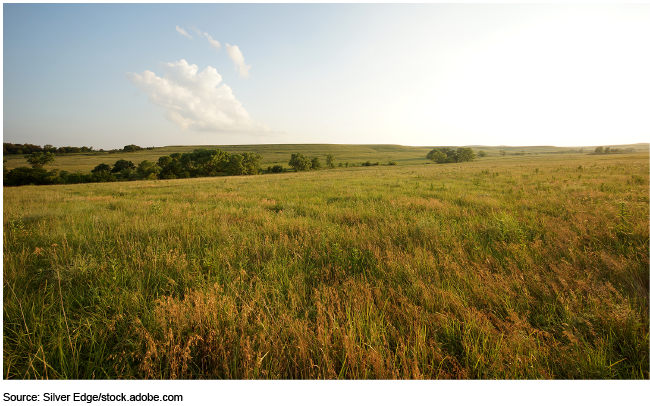Conservation Reserve Program: Improving How USDA Selects Land Could Increase Environmental Benefits
Fast Facts
USDA's Conservation Reserve Program pays farmers to take agricultural lands out of use and devote them to conservation. This can include establishing grasses and trees that help prevent soil erosion and provide wildlife habitat. It also pays ranchers to preserve grasslands. In FY 2023, USDA paid $1.8 billion for 22.9 million acres.
USDA could improve its methods for selecting land to boost program benefits and cost-effectiveness, studies and experts say. This includes using more science-based information to estimate environmental benefits rather than staff's professional judgment.
Our 4 recommendations address this issue and more.

Highlights
What GAO Found
To participate in the U.S. Department of Agriculture's (USDA) Conservation Reserve Program (CRP), landowners and operators take agricultural land out of use and implement conservation practices, or agree to protect grassland, in exchange for annual rental payments. CRP focuses on environmentally sensitive land, such as those on which crop production can result in environmental damage. The program has three types of enrollments—general, continuous, and grassland—that all share some grass-related conservation practices. Continuous enrollment can also include water quality practices.
Examples of Land in USDA's Conservation Reserve Program

To participate in general and grassland enrollments, landowners and operators make competitive offers, which USDA's Farm Service Agency (FSA) scores and selects for acceptance. To score these offers, FSA considers their potential benefits and costs. For example, for general enrollment, FSA calculates an offer's total score by combining points for environmental benefits related to soil erosion, wildlife habitat, and water quality, among other things, with points related to the relative cost. FSA then ranks and selects offers based on their scores. For continuous enrollment, FSA typically automatically accepts offers if they meet certain criteria, except for one project on migratory birds, butterflies, and pollinators, in which offers are competitive.
According to some studies GAO reviewed and experts GAO interviewed, FSA has opportunities to further improve its selection methods to increase the program's environmental benefits and cost-effectiveness. For example, FSA could increase points for establishing native wildflowers that benefit pollinators and expand the use of competition for continuous enrollment. FSA officials agreed that such opportunities could exist.
While FSA has generally made some small changes over the years to its selection methods, it does not have a systematic process to periodically review its methods. In 2023, FSA made a larger change by updating how it estimates soil erosion benefits to increase accuracy. FSA has held some meetings internally, such as after general enrollment periods, and with other federal agencies (most recently in 2019) to discuss its methods for selecting offers. However, developing a process to regularly review its methods would better position FSA to identify potential improvements. Addressing any findings resulting from these periodic reviews could help increase CRP's cost-effectiveness and environmental benefits.
Why GAO Did This Study
CRP is one of the largest USDA conservation programs for agricultural land in the U.S. In fiscal year 2023, USDA provided $1.8 billion in rental payments for 22.9 million acres enrolled in CRP. CRP, which FSA administers, was established by the Food Security Act of 1985 and most recently reauthorized by the Agriculture Improvement Act of 2018. It has three types of enrollment—general, which includes land that may have at least a certain level of soil erosion; continuous, which focuses on small, targeted portions of land; and grassland, which is typically used for livestock grazing. CRP's implementing regulation cites cost-effectiveness as one objective.
GAO was asked to review FSA's oversight of CRP. This report, among other things, examines the methods FSA uses to select CRP offers and the extent to which FSA reviews these methods and updates them as needed.
To conduct this review, GAO analyzed USDA documents and interviewed eight experts, including current and former USDA officials and academics who authored studies on CRP. GAO also analyzed USDA data on CRP for fiscal years 1986 through 2023.
Recommendations
GAO is making four recommendations, including that FSA develop a process to periodically review its methods for selecting CRP offers, and then address any resulting findings, as appropriate. USDA generally agreed with all four recommendations.
Recommendations for Executive Action
| Agency Affected | Recommendation | Status |
|---|---|---|
| Farm Service Agency | The Administrator of USDA's FSA should build on existing efforts by incorporating, in a timely manner and as appropriate, reliable science-based information from models or other sources into the agency's methods for assigning points that are used to select offers for CRP. (Recommendation 1) |
We will review the agency's actions once we receive documentation.
|
| Farm Service Agency | The Administrator of USDA's FSA should develop a process to periodically review its methods for selecting offers for CRP. Such a process should specify the frequency of the reviews and include soliciting and publicly reporting on suggestions from experts, including non-USDA scientists and economists. (Recommendation 2) |
We will review the agency's actions once we receive documentation.
|
| Farm Service Agency | The Administrator of USDA's FSA should address any findings resulting from its periodic reviews to enhance its methods for selecting offers for CRP, as appropriate. (Recommendation 3) |
We will review the agency's actions once we receive documentation.
|
| Farm Service Agency | The Administrator of USDA's FSA should annually analyze information on environmental benefits by type of enrollment and for the entire program, and publicly report the information, such as on its website. (Recommendation 4) |
We will review the agency's actions once we receive documentation.
|
